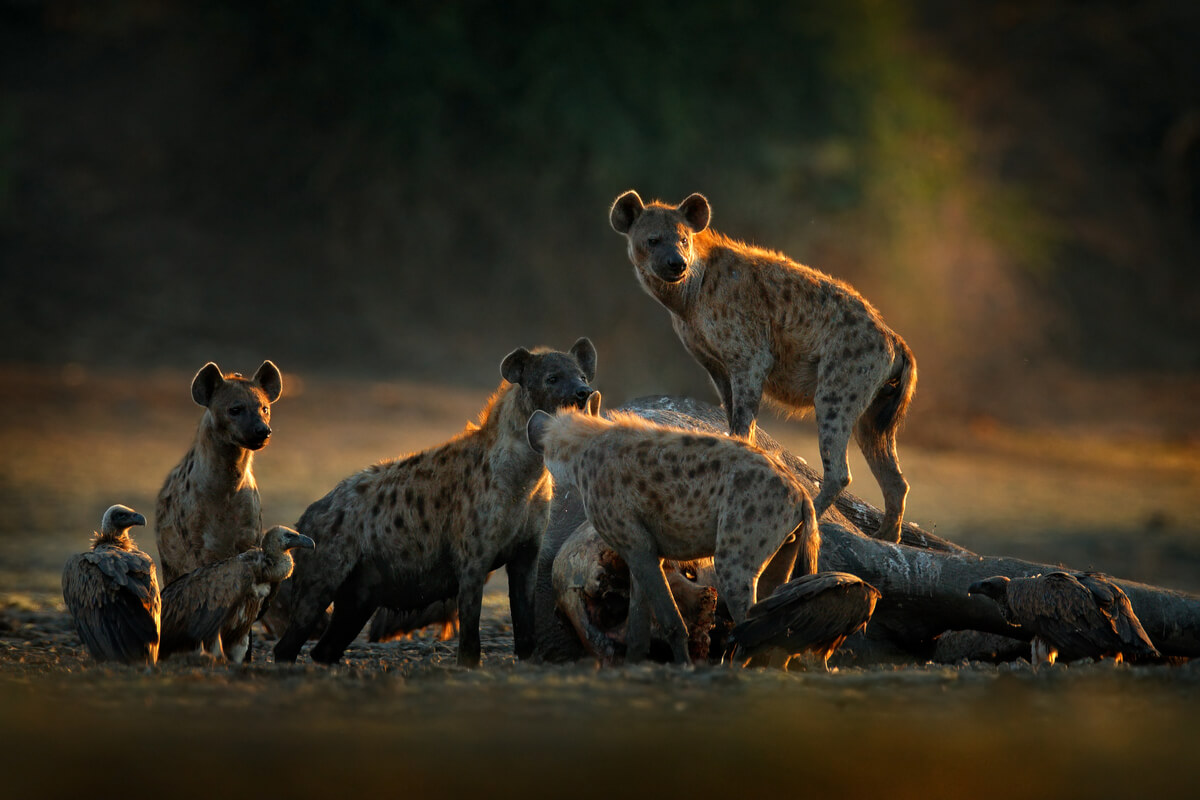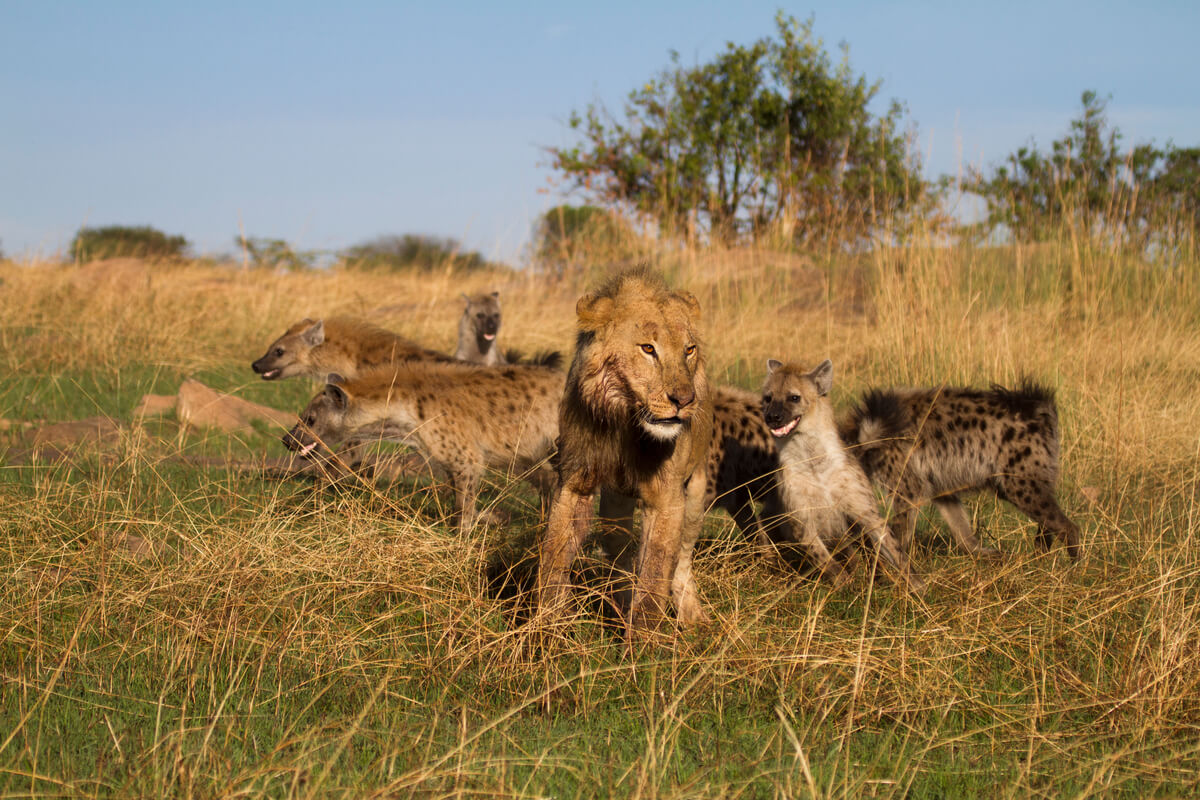How Do Hyenas Hunt?


Written and verified by the biologist Georgelin Espinoza Medina
Carnivorous animals use their best attributes to capture their prey. Some of them are speed, strength, night vision, large jaws, acute hearing and smell, cunning, and perseverance. Although they’re known as scavengers, hyenas are top predators and don’t miss a chance if they see a susceptible victim to stalk. Would you like to know how hyenas hunt? Keep reading to find out!
These mammals are known for their sounds that resemble mocking laughter. They have an interesting way of feeding and surviving, because the environment they live in is very demanding and full of dangers. In the following lines, we’ll show you more about hyenas, including how they feed and hunt. Don’t miss out on all these details about these bold predators.
What do hyenas look like?
Before explaining how hyenas hunt, let’s describe them. First of all, it should be noted that they’re medium-sized mammals (usually between 100 and 160 centimeters long, 3.3 to 5.2 feet). The front pair of legs are longer than the back ones, and their paws have 4 toes and short claws.
Their fur is grayish or brown, with patterns of dark spots or stripes. Some specimens have short hair, while others have long, abundant hair.
These mammals have large ears and a small muzzle with strong jaws with sharp teeth. Their tails are different sizes, depending on the species. They’re nocturnal and live in herds with a hierarchical organization, although there are solitary individuals also. They live in Africa and Asia.

Types of hyenas
Although they have physical characteristics that relate them to canids, hyenas are actually related to felines. They belong to the family Hyaenidae, a not very diverse group, since there are only 4 living species. These are the following:
- Spotted hyena (Crocuta crocuta)
- Brown hyena (Hyaena brunnea)
- Striped hyena (Hyaena hyaena)
- Protelo or ground wolf (Proteles cristata)
What do hyenas eat?
Hyenas are carnivores and are active hunters, but if necessary they also take advantage of the decaying carrion present in the ecosystem. Thanks to this, they play a very important role in the recycling of environmental matter.
The prey they consume are varied, including wildebeest, antelopes, wild boar, young zebras, birds and snakes. Some hyenas may supplement their diet with fruit, especially in seasons when food is scarce.
One species of hyena that has a somewhat strange feeding habit for this group is the ground wolf (P. cristata). This is an insectivorous animal, as it bases its diet on small invertebrates and has special adaptations in its teeth to do so.
How do hyenas hunt?
How hyenas hunt is quite interesting, particularly because of the cunning they demonstrate. These mammals analyze their victims and use all their senses in order to be successful. They’re opportunistic hunters that carefully observe the herds of their potential prey to make the decision regarding which individual to attack.
Hyenas possess several attributes that they employ very well while hunting: sharp eyesight, hearing and smell and strong jaws with sharp teeth, which give them a powerful and lethal bite (capable of breaking bones). In addition to being bold and tough runners, these animals are very strong.
The aspects related to prey capture are well-documented thanks to observations made in natural environments, especially in the spotted species (C. crocuta). Here are some facts about their hunting behavior.
Do hyenas hunt alone or in packs?
Although spotted hyenas live in fairly large groups or clans (up to 80 members), they usually carry out their hunting behavior in packs with few individuals (2 to 4). However, hyenas have also been observed hunting alone when killing small prey (such as hares).
Larger hunting groups (of about 12 hyenas) have been detected when the prey is large or when there are mothers with offspring. Mothers tend to fiercely defend their young, so extra backup is required to finish off the victim.
When do hyenas hunt, day or night?
Hyenas are known to be nocturnal hunters, but this preference isn’t related to the need to hide in the dark. Rather, it’s a strategy to cope with ambient temperatures, which are very high in desert ecosystems when the sun is at its hottest.
Nighttime hours are cooler than daytime hours, which ensures better chase performance. It has been documented that hyenas can hunt by day during the coldest months of the year.
How do they select their prey?
Hyenas head towards herds of potential prey (distant from each other), speed up, and then stop when they’re close. This action generates displacement in the animals, so they can observe and find an individual with a weakness. If they don’t succeed, they lose interest in that group and look for another herd.
This strategy increases the chances of success and ensures that the energy invested in hunting isn’t wasted.
What’s the chase like?
When identifying their prey, hyenas execute an active chase downwind and are persistent. The pursuit of the prey can be carried out for a short or long period depending on the animal itself. When the prey is larger, extra effort is required, and the hunting time can be prolonged.
Behavior when catching the prey
Once the victim is caught, hyenas surround it and tear it apart, starting with the viscera (they also like to separate the legs). On the other hand, when it comes to smaller prey, they can swallow them in one bite. At the moment of eating large animals, more hyenas arrive, either from the same clan or from another surrounding one.

In conclusion, the way hyenas hunt shows interesting strategies that have allowed them to succeed. Whether they hunt alone or in packs, day or night, these mammals use their intelligence to make the right decisions. They also have developed senses, strong jaws, and fast legs that undoubtedly make them intimidating predators.
All cited sources were thoroughly reviewed by our team to ensure their quality, reliability, currency, and validity. The bibliography of this article was considered reliable and of academic or scientific accuracy.
- Ahmim, M., Lakouachet, D., & Aliane, D. (2021). Data on ethology and behavior of the striped hyena Hyaena hyaena (Linnaeus, 1758) under captive conditions in Algeria. Biodiversity International Journal, 5(1), 19-23.
- Cooper, S. (1990). The hunting behaviour of spotted hyaenas (Crocuta crocuta) in a region containing both sedentary and migratory populations of herbivores. African Journal of ecology, 28, 131-141.
- Holekamp, K., Sakai, S., & Lundrigan, B. (2007). The spotted hyena (Crocuta crocuta) as a model system for study of the evolution of intelligence. Journal of Mammalogy, 88(3), 545-554.
- Owens, M., & Owens, D. (1978). Feeding ecology and its influence on social organization in Brown hyenas (Hyaena brunnea, Thunberg) of the Central Kalahari Desert. The East African Wildlife Journal, 16, 113-135.
- Proteles cristata, Animal Diversity Web (ADW). Recogido a 07 de octubre en: https://animaldiversity.org/accounts/Proteles_cristata/
This text is provided for informational purposes only and does not replace consultation with a professional. If in doubt, consult your specialist.